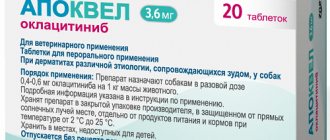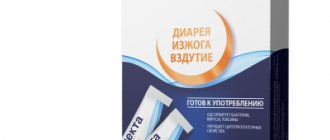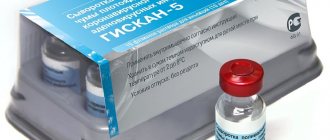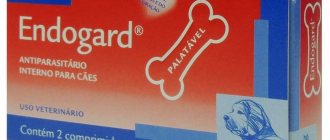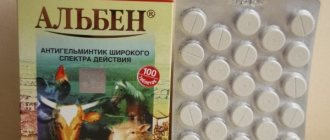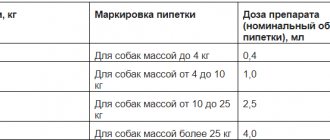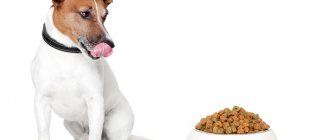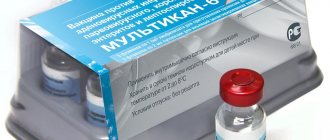Composition and action
The active component of Norocarp tablets for dogs is carprofen. This substance is not a steroid hormone, but it has an anti-inflammatory effect. It eliminates pain and lowers temperature.
During inflammation, the body produces lipid substances - prostaglandins. They cause tissue hyperemia, pain and swelling. Carprofen suppresses their formation. This leads to a significant improvement in the animal's condition.
The active component of the drug belongs to the latest generation of non-hormonal anti-inflammatory drugs. Carprofen does not affect the functioning of the kidneys, liver and stomach. Undesirable effects during the course of treatment occur much less frequently than with other pain medications.
Carprofen is quickly absorbed into the blood. Within 1 – 3 hours after taking the tablets, the dog’s pain decreases and the temperature decreases. This remedy helps to quickly improve the animal's well-being. 16–18 hours after administration, carprofen is removed from the body through the intestines.
The drug is available in various dosages. Each tablet may contain 20, 50 or 100 mg of active substance.
Dexafort - properties and instructions
Dexafort is no longer a tablet, but an injection suspension. The drug belongs to the glucocorticosteroid group. The active ingredients of Dexafort are phenylpropionate and dexamethasone sodium phosphate. They are absorbed very quickly. Dexafort works within an hour after the injection, the effect lasts up to 100 hours.
Dexafort can not only relieve inflammation, but also reduce the level of sensitivity to allergens. Effective for allergic eczema, dermatitis, swelling after injury, joint diseases, asthma, mastitis.
Dexafort is prescribed to dogs subcutaneously or intramuscularly at a dose of 0.05 ml per kg of body weight once. After 7 days, a second injection is possible. Shake the Dexafort bottle thoroughly before use.
Dexafort should not be prescribed to pets with fungal infections, diabetes, kidney disease, or heart disease. Do not inject it for osteoporosis, ulcers, or pregnant dogs.
All non-steroidal anti-inflammatory drugs should be used strictly after meals (if they are tablets) and if any reaction occurs, especially diarrhea, stop using the drug.
Indications
Instructions for the use of Norocarp tablets for dogs recommend using this remedy for acute and chronic joint diseases:
- arthritis;
- osteochondrosis;
- arthrosis;
- vertebral hernias;
- tendon inflammation.
The drug helps relieve pain and injuries:
- fractures;
- sprains;
- bruises;
- dislocations.
Tablets can also be given to a dog at high temperatures during inflammation. They will help relieve fever and improve the animal’s condition.
In addition, the drug is indicated for dogs after surgery. This quickly eliminates pain associated with surgery.
Description, composition, release form
“Norocarp” for dogs is in the form of tablets and contains instructions for use in the package.
Did you know? Dog owners move 66% more than the average person.
It looks like a white round tablet with a dividing line in the middle, packaged in a blister (10 pcs.) or a glass bottle (100 pcs.). Depending on the dosage of the active substance, there are 3 types:
- 20 mg;
- 50 mg;
- 100 mg.
In the international classification it is listed as carprofen.
The effectiveness of Norocarp lies in its composition, which includes:
- carprofen;
- lactose monohydrate (57%) (used to give the tablet a pleasant taste);
- microcrystalline cellulose (23%);
- polyvinylpyrrolidone K 30 (2%);
- croscarmellose sodium (3%) and lauryl sulfate (0.8%);
- 0.5% magnesium stearate.
Drugs with anti-inflammatory properties include: “Surolan”, “Amit” and “Ketofen”.
The advantages of Norocarp include:
- fast action (30 minutes after administration);
- affects the sources of pain without disrupting the functioning of the digestive system and other physiological processes;
- it’s easy to choose the dosage for an animal, regardless of weight;
- slows down the aging process in animal bones.
Contraindications
Under no circumstances should the drug be given to an animal if the pet has an increased sensitivity to non-hormonal anti-inflammatory drugs. Taking the tablets should be stopped if the dog experiences the following symptoms:
- diarrhea;
- itching and inflammation of the skin;
- vomit.
In such cases, you need to contact your veterinarian about changing the medication.
If your pet has had allergic reactions to Aspirin in the past, then Norocarp should not be taken. Hypersensitivity to acetylsalicylic acid is usually combined with poor tolerance to carprofen and other non-steroidal drugs to relieve inflammation and pain.
The medicine is strictly contraindicated for small puppies under 6 months of age, as well as pregnant and lactating animals.
The instructions for use of Norocarp for dogs also do not recommend taking tablets for the following diseases and conditions:
- ulcers in the gastrointestinal tract;
- pathologies of the heart and blood vessels;
- dehydration;
- weight deficiency;
- severe renal and liver failure;
- blood circulation disorders;
- low blood pressure.
These pathologies are relative contraindications for taking the drug. If the above diseases are in remission, then in case of urgent need, the veterinarian may prescribe Norocarp. However, in such cases, a reduced dosage of tablets and constant medical monitoring of the animal’s condition are necessary.
Safety and personal hygiene
Dog owners should not forget about the rules of personal hygiene when using Norocarp:
- You cannot smoke or eat during this time;
- If the substance comes into contact with skin or mucous membranes, immediately rinse the area of contact with water;
- work with tablets with gloves;
- At the end you need to wash your hands with soap.
Read about dog diseases such as: piroplasmosis, elbow bursitis, aspergillosis, dirofilariasis, lichen, demodicosis, enteritis, also find out how to cure a dog from subcutaneous ticks and fleas. You can protect your dog from flea and tick attacks with the help of Frontline.
If the drug has entered the human body internally or caused an allergic reaction, you must seek help from specialists, be sure to take the Norocarp instructions with you.
Undesirable effects
Norocarp tablets for dogs belong to class 3 of dangerous drugs. This means that they cause undesirable effects only in the presence of contraindications, overdose or hypersensitivity to carprofen. This medicine cannot be used independently. It can only be given to an animal on the recommendation of a veterinarian.
The instructions for Norocarp tablets for dogs warn of the following side effects:
- Dyspeptic phenomena. Animals hypersensitive to anti-inflammatory drugs may experience diarrhea, nausea, and vomiting.
- Decreased appetite. Some dogs refuse to eat while taking the drug.
- Skin itching. This symptom is observed in dogs allergic to carprofen.
- Depressed state. Some animals feel lethargic, weak and apathetic during the course of treatment.
- Stomach bleeding. Discharge of blood from the gastrointestinal tract is most often observed with an overdose of the drug, as well as when treating dogs with stomach ulcers.
If such symptoms occur, you should immediately stop taking the tablets and consult a veterinarian.
Side effects and overdose
In terms of the degree of impact on the body, norocarp injections and tablets are classified as moderately hazardous substances of class III. If the drug is used incorrectly, overdose, or individual intolerance, adverse reactions may occur:
- diarrhea, vomiting, increased salivation;
- change in color, smell, frequency of bowel movements;
- decreased or increased appetite;
- deviations from the usual drinking regime;
- anemia, pallor, redness or yellowness of the skin and eyes;
- change in behavior, depression;
- pain in the epigastric (lower abdominal) part of the abdomen;
- bleeding and ulcers in the gastrointestinal tract.
If one or more symptoms appear, stop taking the drug immediately and seek help from a specialist. There is no antidote for carprofen; treatment for adverse reactions is carried out locally, based on symptoms.
Important! Ignoring the symptoms of an overdose or an allergic reaction can lead to the death of the animal.
Admission rules
The Norocarp instructions for dogs recommend calculating the amount of the drug based on the dosage - 4 mg of the drug per 1 kg of animal weight. For small dogs, the tablet must be carefully divided into several parts. The daily dose is divided into two doses.
It is recommended to give the drug to the animal during meals, since its active ingredient irritates the gastric mucosa.
If the dog cannot swallow the medicine, then crushing the tablets is allowed. The resulting powder can be mixed into food. You can also add crushed tablets to water and pour them into the animal's mouth using a syringe.
If a dose of the drug was accidentally missed, then there is no need to give the dog a double dose of the drug. In this case, it is enough to return to the usual regimen.
The duration of taking Norocarp tablets for dogs may vary. For inflammatory joint diseases, the animal is given 4 mg of medication per 1 kg of weight for a week, and then switched to a dosage of 2 mg/kg. The drug is used until the animal recovers completely. For chronic pathologies of the musculoskeletal system, lifelong use of tablets is possible.
If the drug is used to relieve pain after surgery, the tablets are given to the dog once. If necessary, repeat the dose after 24 hours.
Norocarp injection for cats and dogs
The drug is a yellowish transparent liquid, packaged in dark glass bottles of 20; 50 ml.
The cost of 20 ml Norocarp for injection and 50 ml Norocarp agricultural in July 2022 was 1980 and 2318 rubles.
The drug is prescribed for pathologies of the musculoskeletal system - arthrosis, arthritis, dislocations, bruises, as well as for the relief of postoperative pain.
Norocarp is administered intravenously or subcutaneously in an amount of 0.08 ml/kg body weight of a cat or dog. If necessary, the drug is administered to dogs every other day at half the dose. In case of an overdose, the animal is depressed, vomiting and gastric bleeding occur. Hypersensitive pets develop an allergic reaction, which is eliminated with antihistamines.
Norocarp is incompatible with glucocorticosteroids, anticoagulants, diuretics, and antiphlogistants. The medicine is contraindicated in animals with renal or heart failure.
special instructions
Norocarp tablets for dogs may interact with other medications. This drug should not be used in combination with the following groups of medications:
- other non-steroidal anti-inflammatory drugs;
- anticoagulants;
- diuretics;
- corticosteroid hormones.
You can start taking Norocarp only 24 hours after stopping the above medications. Otherwise, the risk of unwanted effects increases.
First month after surgery
The dog began to lean on the sore paw only at the beginning of the second month after the operation. Before this, she rode exclusively on three, which led to noticeable degeneration of the operated paw. The neighboring paw, on the contrary, was greatly pumped up and hypertrophied.
The doctor advised to speed up the process of getting on his paw by starting to give Previcox and gabapentin. From the first days after starting to take Previcox, the dog began to lean on its paw - this is hardly a lucky coincidence.
The doctor explained that Previcox is given solely so that the dog learns to walk on all fours again. As it turned out, some dogs are characterized by such a situation when they get used to jumping on three legs, and continue to do this even after the latter has fully recovered. In addition, this was supposed to help with dystrophy of the operated paw.
Price and analogues
The cost of Norocarp for dogs in pharmacy chains ranges from 2,000 to 4,500 rubles per 100 tablets. The price of the drug depends on the dosage. Blisters containing 10 tablets are also produced. Their cost is from 200 to 450 rubles.
Pet owners are often interested in cheaper drugs with similar effects. Complete structural analogues of the drug include:
- "Ketofen";
- "Rimadyl."
Let's look at these tools in more detail. Their active substance is also carprofen. The drug "Ketofen" can be used to treat small puppies aged 1.5 months. This medicine is available in the form of tablets and solution for injections. Its price ranges from 500 to 1,000 rubles.
"Rimadyl" tablets contain various flavoring additives. This product is also available in injection form. In terms of its effect on the body, this medicine is practically no different from Norocarp. The cost of the drug is from 500 to 800 rubles.
Instructions for use
The tablets are given whole or crushed and mixed with a small amount of water. The resulting suspension can be taken from a disposable syringe without a needle. It is better to give the medicine 2 times a day, before meals. If you miss a dose, the course is resumed; a one-time failure does not have a negative effect.
The tablets are given whole or crushed and mixed with a small amount of water.
The dose is calculated individually and depends on the condition and weight of the dog. The standard regimen involves using 1 tablet per 5 kg of dog weight. Therapy lasts 7 days, then treatment can be continued by reducing the daily dose of the medication by half. The doctor may prescribe a different dosage regimen, it all depends on the disease and the overall treatment program.
Reviews from veterinarians
Veterinarians speak of Norocarp as a fairly powerful pain reliever. It is prescribed only for severe pain. Before the course of treatment, experts recommend doing a blood test for the animal. Anti-inflammatory drugs negatively affect the coagulation process and can cause bleeding.
Experts recommend monitoring your animal's stool during the course of treatment. If a dog experiences bloody diarrhea during therapy, the tablets should be discontinued.
Veterinarians also irritate the gastric mucosa. Therefore, specialists simultaneously prescribe the drug Ranitidine, which reduces the production of gastric juice. This allows you to reduce the aggressive effects of carprofen on the gastrointestinal tract.
Symptoms of hip dysplasia in a Rottweiler
So, the symptoms of hip dysplasia that we observed:
- The most important symptom, which is why we started ringing the alarm, is loud whining when getting up from the floor.
- The dog became sharply lethargic; If earlier she very actively rowed with all four of them after her favorite toy, now she preferred to lie in the corner.
- When standing, the hind legs were not parallel to each other, but converged down to almost one point.
- When running, the dog pushed off with its hind legs simultaneously, like a rabbit.
- When the dog whined and we approached her to pet her, she watched her hands very carefully when her hands touched her hips: apparently she was afraid that we might hurt her.
Video about how he moves his hind legs with dysplasia:
Actually, the first x-ray (at the Vita clinic, Taganrog, Lomakina 125/1) confirmed our fears - the dog was diagnosed with dysplasia of both hind limbs.
Reviews from dog owners
Pet owners leave positive reviews about Norocarp for dogs. For arthritis and osteochondrosis, this medicine quickly eliminates pain in the neck and paws. After a two-week course of treatment, the dogs' lameness disappeared. The animals quickly returned to their previous active lifestyle.
You can also find negative reviews about the drug. They are associated with side effects of the drug. During the course of treatment, some animals experienced diarrhea, refusal of food and water, and bleeding from the gastrointestinal tract. Due to the risk of unwanted effects, many dog owners are wary of giving these tablets to their pets.
It is important to remember about contraindications to the use of the drug. Most often, side effects develop in dogs with chronic diseases of the gastrointestinal tract. Before using such a strong painkiller, the animal must undergo a comprehensive examination. If the dog’s condition worsens at the slightest during treatment, it is necessary to show the pet to a veterinarian. Only a specialist will be able to select more gentle means for therapy.
In six months
Autumn 2022, an x-ray was taken, after which it became clear: the dysplasia had not gone away, but the acetabulum (into which the femur is inserted) had become very bad.
The dog's symptoms did not correspond to the severity of the disease: the dog practically did not whine (i.e., occasionally whined when standing up a couple of times a week, after physical exertion or a long walk with games). At the same time, the male continued to place his paws incorrectly, bringing the toes of his paws to one point.
A distinctive feature of the dog’s behavior was the desire to constantly sit down: while other dogs stood, walked, sniffed and played, our friend preferred to sit. Or, better yet, lie down.
An X-ray of a one and a half year old Rottweiler with hip dysplasia looked like this.
It was decided to perform resection of the femoral heads. At the moment (autumn 2019) one paw has been made; The family has not finally made a decision on the second one.
One and a half years after surgery
A year and a half after the operation, some details may already be blurred in memory, however, I will try to write what I remember.
Despite the fact that the dog began to lean on the operated paw at the end of the first/beginning of the second month, the dog began to fully walk on four legs only at the end of the third month. The doctor advised me to buy weights for the sore paw to force the dog to lean on it, and so that he gets tired of holding it while flying. However, often the dog preferred to drag its paw rather than step on it. Perhaps this is a characteristic feature of my fearful and sensitive dog, but this is my experience.
Six months after the operation, the muscle function of the operated paw was completely restored: the paws became symmetrical, and the gait was no longer lame. However, we preferred (and still prefer, at 1.5 years after the operation) not to load the hind legs - no booms, jumps, stairs to a minimum.
One year after the operation, we took x-rays of both hip joints in the dog to evaluate the condition of both joints. The veterinarian said that the operated limb was in normal condition (for an operated limb); the second paw continues to remain in poor condition, however, there is no dynamics (neither positive nor negative). Therefore, it was decided to postpone the resection of the head of the second femur for at least another year, and at most forever. X-ray from below.
X-ray one year after surgery
After a year and a half, the situation is as follows: in the absence of serious physical activity (sleep at home for a couple of hours + 1.5-2 hours of walking daily) there are no problems. The dog gets up and lies down normally without any problems. If the dog was active - running, jumping, or just walking over a long distance of 4-5 km - the dog prefers to lie down most of the time. Only once in a year and a half was there a situation where the dog whined when getting up - that evening we walked for a very long time (almost two hours) at a brisk pace.
Also, about a year after the operation, we went to the sea, where the dog swam almost unlimitedly (several hours continuously every day) with his beloved owner. They say that swimming is extremely beneficial for joints; however, even without taking into account this usefulness, the dog swam and rowed with great pleasure for hours (!) without getting tired. To be on the safe side, we put her in a doggie life jacket to take some of the pressure off her paws—I doubt she could have swam that much without it.


